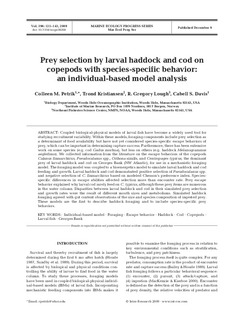| dc.description.abstract | Coupled biological-physical models of larval fish have become a widely used tool for studying recruitment variability. Within these models, foraging components include prey selection as a determinant of food availability but have not yet considered species-specific escape behaviors of prey, which can be important in determining capture success. Furthermore, there has been extensive work on some species (e.g. cod Gadus morhua), but less on others (e.g. haddock Melanogrammus aeglefinus). We collected information from the literature on the escape behaviors of the copepods Calanus finmarchicus, Pseudocalanus spp., Oithona similis, and Centropages typicus, the dominant prey of larval haddock and cod on Georges Bank (NW Atlantic), for use in a mechanistic foraging model. The foraging model was coupled to a bioenergetics model to simulate larval haddock and cod feeding and growth. Larval haddock and cod demonstrated positive selection of Pseudocalanus spp. and negative selection of C. finmarchicus based on modeled Chesson’s preference index. Species-specific differences in escape abilities affected selection more than encounter rate. Prey escape behavior explained why larval cod rarely feed on C. typicus, although these prey items are numerous in the water column. Disparities between larval haddock and cod in their simulated prey selection and growth rates were the result of different mouth sizes and metabolisms. Simulated haddock foraging agreed with gut content observations of the size and species composition of ingested prey. These models are the first to describe haddock foraging and to include species-specific prey behaviors. | no_NO |
